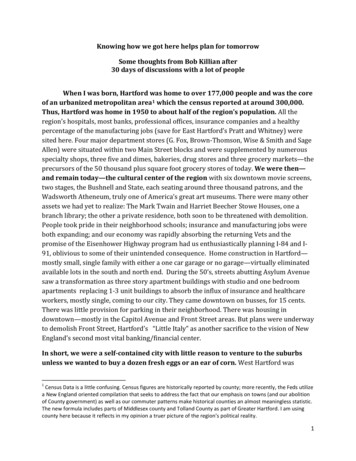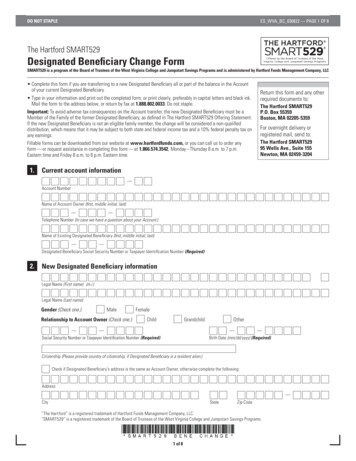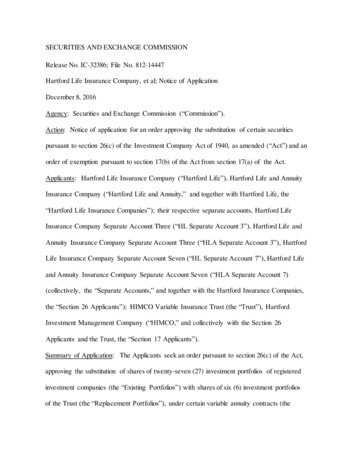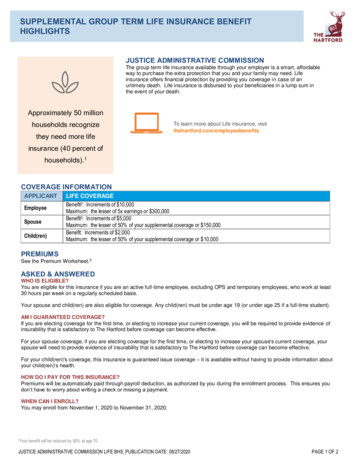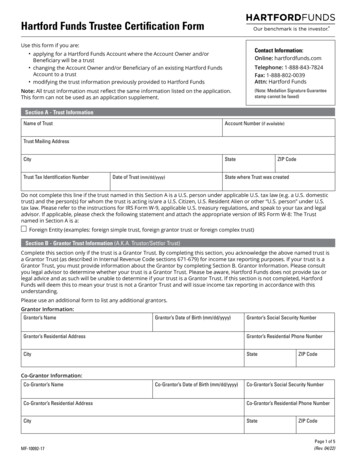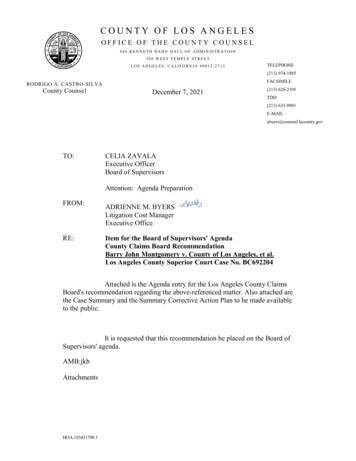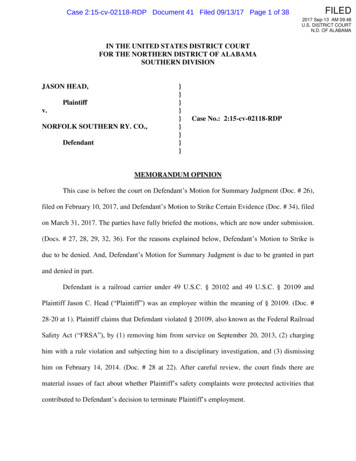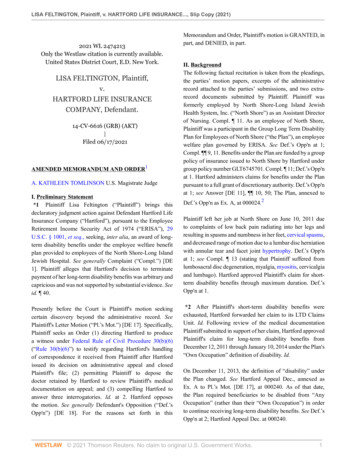
Transcription
LISA FELTINGTON, Plaintiff, v. HARTFORD LIFE INSURANCE., Slip Copy (2021)2021 WL 2474213Only the Westlaw citation is currently available.United States District Court, E.D. New York.LISA FELTINGTON, Plaintiff,v.HARTFORD LIFE INSURANCECOMPANY, Defendant.14-CV-6616 (GRB) (AKT) Filed 06/17/2021AMENDED MEMORANDUM AND ORDER1A. KATHLEEN TOMLINSON U.S. Magistrate JudgeI. Preliminary Statement*1 Plaintiff Lisa Feltington (“Plaintiff”) brings thisdeclaratory judgment action against Defendant Hartford LifeInsurance Company (“Hartford”), pursuant to the EmployeeRetirement Income Security Act of 1974 (“ERISA”), 29U.S.C. § 1001, et seq., seeking, inter alia, an award of longterm disability benefits under the employee welfare benefitplan provided to employees of the North Shore-Long IslandJewish Hospital. See generally Complaint (“Compl.”) [DE1]. Plaintiff alleges that Hartford's decision to terminatepayment of her long-term disability benefits was arbitrary andcapricious and was not supported by substantial evidence. Seeid. ¶ 40.Presently before the Court is Plaintiff's motion seekingcertain discovery beyond the administrative record. SeePlaintiff's Letter Motion (“Pl.’s Mot.”) [DE 17]. Specifically,Plaintiff seeks an Order (1) directing Hartford to producea witness under Federal Rule of Civil Procedure 30(b)(6)(“Rule 30(b)(6)”) to testify regarding Hartford's handlingof correspondence it received from Plaintiff after Hartfordissued its decision on administrative appeal and closedPlaintiff's file; (2) permitting Plaintiff to depose thedoctor retained by Hartford to review Plaintiff's medicaldocumentation on appeal; and (3) compelling Hartford toanswer three interrogatories. Id. at 2. Hartford opposesthe motion. See generally Defendant's Opposition (“Def.’sOpp'n”) [DE 18]. For the reasons set forth in thisMemorandum and Order, Plaintiff's motion is GRANTED, inpart, and DENIED, in part.II. BackgroundThe following factual recitation is taken from the pleadings,the parties’ motion papers, excerpts of the administrativerecord attached to the parties’ submissions, and two extrarecord documents submitted by Plaintiff. Plaintiff wasformerly employed by North Shore-Long Island JewishHealth System, Inc. (“North Shore”) as an Assistant Directorof Nursing. Compl. ¶ 11. As an employee of North Shore,Plaintiff was a participant in the Group Long Term DisabilityPlan for Employees of North Shore (“the Plan”), an employeewelfare plan governed by ERISA. See Def.’s Opp'n at 1;Compl. ¶¶ 9, 11. Benefits under the Plan are funded by a grouppolicy of insurance issued to North Shore by Hartford undergroup policy number GLT6745701. Compl. ¶ 11; Def.’s Opp'nat 1. Hartford administers claims for benefits under the Planpursuant to a full grant of discretionary authority. Def.’s Opp'nat 1; see Answer [DE 11], ¶¶ 10, 50; The Plan, annexed toDef.’s Opp'n as Ex. A, at 000024.2Plaintiff left her job at North Shore on June 10, 2011 dueto complaints of low back pain radiating into her legs andresulting in spasms and numbness in her feet, cervical spasms,and decreased range of motion due to a lumbar disc herniationwith annular tear and facet joint hypertrophy. Def.’s Opp'nat 1; see Compl. ¶ 13 (stating that Plaintiff suffered fromlumbosacral disc degeneration, myalgia, myositis, cervicalgiaand lumbago). Hartford approved Plaintiff's claim for shortterm disability benefits through maximum duration. Def.’sOpp'n at 1.*2 After Plaintiff's short-term disability benefits wereexhausted, Hartford forwarded her claim to its LTD ClaimsUnit. Id. Following review of the medical documentationPlaintiff submitted in support of her claim, Hartford approvedPlaintiff's claim for long-term disability benefits fromDecember 12, 2011 through January 10, 2014 under the Plan's“Own Occupation” definition of disability. Id.On December 11, 2013, the definition of “disability” underthe Plan changed. See Hartford Appeal Dec., annexed asEx. A to Pl.’s Mot. [DE 17], at 000240. As of that date,the Plan required beneficiaries to be disabled from “AnyOccupation” (rather than their “Own Occupation”) in orderto continue receiving long-term disability benefits. See Def.’sOpp'n at 2; Hartford Appeal Dec. at 000240. 2021 Thomson Reuters. No claim to original U.S. Government Works.1
LISA FELTINGTON, Plaintiff, v. HARTFORD LIFE INSURANCE., Slip Copy (2021)Based on this Policy change, Hartford commenced a reviewof Plaintiff's claim for long-term disability benefits. See Def.’sOpp'n at 1-2. As part of this review, Hartford consideredthe Special Investigation Unit file associated with Plaintiff'sclaim, a Labor Market Analysis performed by a HartfordVocational Rehabilitation Clinical Case Manager, and anIndependent Medical Examination (“IME”) of Plaintiffperformed by Dr. Olugbenga Dawodu (“Dr. Dawodu”).3Seeid. at 2. According to Hartford, it requested that independentvendor D&D Associates (“D&D”) retain a physician boardcertified in internal medicine and occupational medicine toperform the IME of Plaintiff. Id. at 2 n.2. D&D retained Dr.Dawodu, who is board-certified in these areas. See id. at 2.According to the Complaint, Dr. Dawodu found that Plaintiffwas not disabled and that “there was no objective medicalevidence of disability.” Compl. ¶ 32.By letter dated January 10, 2014, Hartford terminatedPlaintiff's long-term disability benefits. See Hartford AppealDec. at 000240.4 Hartford informed Plaintiff that she wasno longer entitled to receive long-term disability benefitsbecause, based upon its review of the information in herclaim file, Hartford had determined that she was not preventedfrom performing the essential duties of “Any Occupation” asdefined by the Plan. Id.; see Def.’s Opp'n at 2; Compl ¶ 14.On June 6, 2014, Plaintiff filed an administrative appeal toreverse Hartford's adverse benefits determination. See Compl.¶ 17; Pl.’s Mot. at 1. In support of her appeal, Plaintiffsubmitted, as relevant here, a May 16, 2014 FunctionalCapacity Evaluation Summary Report (“FCE Report”) byBest Physical Therapy (“Best”). See FCE Report, annexedas Ex. 2 to Def.’s Opp'n, at 000391-000406; Compl. ¶ 24.5According to the FCE Report, Best's findings are basedon a three-hour evaluation of Plaintiff performed by SusanGreenberg, M.S., P.T. (“Greenberg”) at Best's Pelham office.See FCE Report at 000393. The FCE Report states thatPlaintiff “underwent an intensive physical assessment and acomprehensive functional test” to determine, inter alia, herability to perform “light work” for an eight hour-day, fivedays a week. Id. at 000403-000404. The FCE Report notesthat Dr. Dawodu concluded based on his IME that Plaintiffcould return to “light duty.” Id. at 000404. However, theFCE Report concludes, among other things, that Plaintiff “isunable to perform ‘light work,’ based upon the Dictionaryof Occupational Titles’ Definition” and “is unable to workeven at the sedentary level at this time.” Id. at 000405.Specifically, the FCE Report states: “Ms. Feltington suffersfrom a variety of symptoms due to her diseases, causingprofound and complex multifactorial limitations. She isunable to work at this time, and due to the chronic natureof her systemic diseases (e.g., low back pain with radicularpain), at any time in the near future.” Id. at 000406; seealso Compl. ¶¶ 22-26 (summarizing conclusions regardingPlaintiff's physical limitations set forth in the FCE Report).*3 In considering Plaintiff's administrative appeal, Hartford“requested that independent medical record peer reviewvendor University Disability Consortium (‘UDC’) retaina board-certified orthopedist to review [Plaintiff's] recordsand provide an opinion concerning her functional capacity.”Def.’s Opp'n at 2. UDC retained Dr. Neal Small (“Dr. Small”),a board-certified orthopedic surgeon, to perform this review.See id.Dr. Small provided Hartford with a Medical Record Reviewreport (“MRR”), dated September 12, 2014, regarding hisreview of Plaintiff's medical file. See MRR, annexed as Ex.B to Pl.’s Mot. [DE 17]. According to the MRR, Dr. Smallreviewed the following documentation in Plaintiff's file: (1)MRI reports and x-ray reports; (2) records from Dr. Farrugia,Dr. Reginald Rosseau, M.D., Dr. Porges, and Dr. Fazzini; (3)Dr. Dawodu's IME report; (4) the FCE Report from Best;(5) and two surveillance videos of the Plaintiff. See id. at000356-00361. In summarizing the FCE Report, the MRRstates:An unusual functional capacity evaluation, which isunsigned, is reviewed from Best Physical Therapy. Thiswas performed on May 16, 2014. The pertinent findingsfrom this evaluation purport that the claimant couldonly lift 16lbs, and only from a 24 inch high level.She could carry in front 16lbs and to either side 14lbs.She could push 42lbs and pull 43lbs. She was allegedlyfound to have a poor sitting tolerance. The individualwho completed this report concluded that ‘the claimant'sphysical abilities do not match the job description of aquality assurance coordinator’ because:She could not sit for frequent and continuous periodsof time without trunk flexion and rotation.She could walk only rarely.She could not reach overhead.She could only lift 16lbs from a 24 inch height. 2021 Thomson Reuters. No claim to original U.S. Government Works.2
LISA FELTINGTON, Plaintiff, v. HARTFORD LIFE INSURANCE., Slip Copy (2021)She could only side-carry 14lbs. Her right handcoordination was ‘less than average; particularly, withfine and gross motor skills.’The author of this report who is, at this time,anonymous, concluded that the claimant was ‘unable todo light work’ and also concluded that the claimant was‘unable to do sedentary work.’Id. at 000359-000360 (emphasis supplied). Ultimately, Dr.Small concluded that the “unsigned” FCE Report by Best“appears to be less than objective” because its findings “areinconsistent with the findings at the examination performedby Dr. Dawodu” as well as Plaintiff's “activity level displayedon the surveillance videos” observed by Dr. Small. Id. at000362.Under the subheading entitled “Attending Physician ContactDocumentation,” the MRR states that Dr. Small “ha[d] notbeen asked to contact an [Attending Physician] regarding the[Plaintiff],” but that he “ha[d] been asked to contact BestPhysical Therapy Associates.” Id. at 000361. According toDr. Small,On August 9, 2014 at 2pm Central Standard Time Iplaced a call to [Best at] 914 708.6548. I reached arecorded voicemail message from a Karen Cavenaughasking for me to leave a message. I left my nameand return phone number. I called again on August 10,2014 at 1:15 pm Central Standard Time again reachingvoicemail. I left another message to return my call. OnAugust 11, 2014 at 10:30 am Central Standard Time, Iplaced a third call and reached the same voicemail. Onceagain, I left a message to return my call.Id. Thus, according to the MRR, Dr. Small never spoke with arepresentative at Best, despite his multiple attempts to do so.*4 Based on his review of Plaintiff's medical file, Dr. Smallconcluded that Plaintiff was capable of working an eighthour workday, five days a week, at a sedentary job, withcertain restrictions and limitations outlined in the MRR. Id. at000362-000363. Dr. Small further notes in the MRR that his“medical opinions are independent of any claims decisionsor the referring agency” and that he “ha[s] encountered noconflicts of interest in the performance of this review.” Id. at000356.On September 26, 2014, Hartford issued a letter upholdingits initial decision to terminate Plaintiff's claim for longdisability benefits under the Plan. See Hartford Appeal Dec.,Pl.’s Mot., Ex. A. The letter, written by Hartford AppealsSpecialist Raichelle Gibbs (“Gibbs”), states that Hartford'sdecision on appeal was based on “the Policy language andall documents contained in [Plaintiff's] claim file viewed as awhole,” including Dr. Small's MRR and the IME completedby Dr. Dawodu. Id. at 000239-000240. The letter summarizes,inter alia, the records reviewed by Dr. Small and his findingswith respect to those records, including the FCE Report byBest. See id. at 000242. Specifically, the letter reiteratesDr. Small's notations in the MRR that the FCE Report is“unsigned” and that the author of the report is “unknown.”Id. at 000242-000243. The letter further states that Dr. Small“attempted to contact Best Physical Therapy Associates onAugust 9, 2014, August 10. 2014 and August 11, 2014 todiscuss [Plaintiff's] current level of function. His calls havenot been returned to date.” Id. at 000242. The letter concludes,as relevant here:The restrictions and limitations outlined by Dr. Dawoduon November 20, 2013 and by Dr. Small on September12, 2014 would not preclude [Plaintiff] from performingAny Occupation as defined in the LTD Policy. TheFCE submitted on appeal from Best Physical TherapyAssociates has not been signed. ·The author of thereport remains unknown at this time. The weight of themedical evidence supports that [Plaintiff] is capable ofperforming Light Work.Id. at 000243.Hartford's letter concludes that the decision to terminatePlaintiff claim was a “final determination” and that Hartfordwould be closing its record on Plaintiff's claim. Id. at 000244.The letter further states: “Please be advised that you haveexhausted any administrative remedies available to yourclient under the Policy and we have closed her claim file atthis time. No further review will be conducted with respect toher claim.” Id.On October 16, 2014, Plaintiff's counsel contacted Gibbs byletter regarding Hartford's decision to uphold its denial ofbenefits and, specifically, Hartford's reliance on “a statementfrom Dr. Small alleging that his calls to Best Physical TherapyAssociates were not returned.” Pl.’s Oct. 16, 2014 Ltr.,annexed to Pl.’s Mot. as Ex. C [DE 17]. Counsel notes thatDr. Small's statement “not only places the [Best] facility inan unfavorable light but infers that information to support thedenial of this claim would have been obtained.” Id. Counselfurther states that, upon forwarding a copy of Hartford'sdecision to Best, he received a response from Greenberg 2021 Thomson Reuters. No claim to original U.S. Government Works.3
LISA FELTINGTON, Plaintiff, v. HARTFORD LIFE INSURANCE., Slip Copy (2021)on October 14, 2014. See id. Greenberg's response, whichcounsel included with his letter to Gibbs, states the following:I am in receipt of the letter you forwarded to me fromThe Hartford regarding Ms. Lisa Feltington. I performeda Functional Capacity Evaluation (FCE) on May 16,2014, on Ms. Feltington. The Hartford letter insinuatesthat the author of the report is unknown, but I bringyour attention to the very first page of the report, whichindicates that the FCE was performed by me at ourPelham facility. Further, I feel that the letter consistentlymisquotes me and takes information out of context. Thisis grossly unfair. The FCE is a three-hour examinationconducted by a Physical Therapist, where the clientactually performs a variety of work related tasks. Thedata is collected and analyzed. A comprehensive reportis written, which includes a list of at least 11 consistencycheckpoints. This is not an IME, where the patient isexamined only briefly. Rather, it is based on actualfunctional ability observed by a Physical Therapist withspecific training in this highly skilled test, directing andmonitoring 30 different tasks that cross validate eachother. In addition, an extensive physical assessment isdone before the testing so that the therapist can assess theclient's level of condition and strength for safety reasons,before the testing begins.*5 The letter goes on to say that Dr. Small called theBEST office on August 9, 10, and 11th. Dr. Small did callonce and left a message for me to call him back, which Idid. He wanted to ask me questions about the FCE but Iinformed him that I would need to reread the file as it hadbeen some time since the FCE had been performed. Dr.Small indicated that I should call him back after I had achance to review the file. I asked a member of my officestaff to phone him and ask him to submit a list of writtenquestions that he had about the FCE so that I could beprepared for the next phone call. I was told that the callhad been placed to him and a message had been left. Tomy knowledge, Dr. Small never called back.I remain more than willing to answer any specificquestions that Dr. Small or the Hartford have regardingMs. Feltington's FCE. Please have them submit thesequestions to me in writing so that we can arrange amutually convenient conference call.Id.by Dr. Small never occurred.” Id. Counsel further assertsthat “Dr. Small's tactics show a clear bias, and a denial ofthe claimant's statutory right to a full and fair review of herclaim.” Id.III. The Instant MotionPlaintiff now seeks to conduct discovery beyond theadministrative record. See generally Pl.’s Mot. In her motion,Plaintiff states that Hartford “used Dr. Small's version ofevents” to support its decision to affirm the denial of Plaintiff'slong-term disability benefits. Id. at 2. Specifically, Hartford“disparage[ed]” the FCE Report “by stating that Dr. Small'scalls to Best Physical Therapy to discuss Plaintiffs levelof function had not been returned” and by “repeat[ing] Dr.Small's comment that Best's report was unsigned and that theauthor remains unknown.” Id. (citing Hartford Appeal Dec.at 000242-000243). Plaintiff has submitted with her motiona copy of the October 16, 2014 letter from Plaintiff's counselto Gibbs and the October 14, 2014 letter from Greenberg(collectively, “the Letters”). See id., Ex. C. Plaintiff points outthat the October 14, 2014 letter from Greenberg “vigorouslydisputed Dr. Small's version of events.” Pl.’s Mot. at 2.Plaintiff further notes that the Letters have not been includedas part of the administrative record and there is no indicationin the record that “Hartford contacted Dr. Small to learn hisversion of events.” Id. According to Plaintiff,Dr. Small's report did not challenge the methodologyutilized in the Best report or the professional opinionrendered. If Dr. Small's version of events was wrong,then Hartford would have no excuse of ignoring thereport's uncontested conclusion. It is clear that Hartfordrelied on his dismissive comments as he had no objectionthat went to the merits of Best's report.Id.In light of the foregoing information, Plaintiff seeks thefollowing extra-record discovery: (1) a Rule 30(b)(6)deposition of Hartford regarding its “handling” of the Letters;(2) a deposition of Dr. Small regarding his conversations withGreenburg from Best; and (3) responses from Hartford to thefollowing three interrogatories:1) State whether Defendant, Hartford InsuranceCompany, has both discretionary authority and madelong term disability payments to Plaintiff pursuant to ThePlan under Hartford Group Policy GL6745701.In his letter to Gibbs, Plaintiff's counsel stated thatGreenberg's response makes clear that “the events described 2021 Thomson Reuters. No claim to original U.S. Government Works.4
LISA FELTINGTON, Plaintiff, v. HARTFORD LIFE INSURANCE., Slip Copy (2021)2) State the number of times that Defendant received amedical review of a long term disability claim from Dr.Neal Small of the University Disability Consortium andthe number of times that he found the claimant to bedisabled.3) State the number of times that Defendant receiveda medical review of a long term disability claim fromDr. Olugbenga Dawodu and the number of times that hefound the claimant to be disabled.*6 Id. at 2; Pl.’s Interrogatories, annexed to Pl.’s Mot. as Ex.D.Plaintiff asserts that she has demonstrated “good cause”to conduct this additional discovery. See Pl.’s Mot. at 4.Primarily, Plaintiff points out that a “structural conflict ofinterest” exists here because Hartford “performs the dual roleof evaluating claims for benefits and paying benefits” underthe Plan. Id. at 3. Acknowledging that this conflict is not, byitself, sufficient to warrant extra-record discovery, Plaintifffurther contends that (1) there were “procedural problems”with Hartford's administrative appeals process; (2) Dr. Smallwas biased and “cease[d] exercising his independent medicaljudgment” with respect to his evaluation of the FCE Report;and (3) UDC, the entity which employs Dr. Small, derivessubstantial portion of its revenue from Hartford. See id. at 3-4.Hartford opposes Plaintiff's motion, arguing that Plaintiffhas not shown that she entitled to any of the extra-recorddiscovery she seeks. See generally Def.’s Opp'n. As apreliminary matter, Hartford contends that the Court shouldlimit its review on this motion to administrative recordand strike the Letters submitted by Plaintiff. See id. at 3n.3. Hartford further contends that there is no need forPlaintiff to conduct a Rule 30(b)(6) deposition regardingthe Letters because those documents are outside of thescope of the administrative record as a matter of law andHartford informed Plaintiff that it would not perform anyfurther reviews in its letter upholding its adverse benefitsdetermination. Id. at 3-4. As for the Plaintiff's requestto depose Dr. Small, Hartford argues that such discovery“is completely inappropriate in this case governed byERISA” and notes that Plaintiff “fails to cite any case lawdemonstrating that this type of discovery is appropriate orhas ever been granted in an ERISA case.” Id. at 4. Finally,Hartford asserts that Plaintiff has also “fail[ed] to identify any‘good cause’ showing regarding her purported entitlement toresponses to her three proposed interrogatories.” Id. at 5.IV. Applicable LawA. Standard Of Review“ERISA does not set out the applicable standard of review foractions challenging benefit eligibility determinations.” Fay v.Oxford Health Plan, 287 F.3d 96, 103 (2d Cir. 2002) (quotingZuckerbrod v. Phoenix Mut. Life Ins. Co., 78 F.3d 46, 49 (2dCir.1996)) (quotation marks omitted). However, the SupremeCourt has held that “a denial of benefits challenged under[ERISA] § 1132(a)(1)(B) is to be reviewed under a de novostandard unless the benefit plan gives the administrator orfiduciary discretionary authority to determine eligibility forbenefits or to construe the terms of the plan.” Firestone Tire &Rubber Co. v. Bruch, 489 U.S. 101, 115 (1989); see Kosakowv. New Rochelle Radiology Assocs., P.C., 274 F.3d 706, 738(2d Cir. 2001) (“[W]here a plan does confer discretion uponthe administrator to determine eligibility or interpret theterms of the plan, the determinations of the administrator arereviewed under an abuse of discretion standard.”). “Whensuch discretionary authority is reserved, a court ‘will notdisturb the administrator's ultimate conclusion unless it isarbitrary and capricious.’ ” S.M. v. Oxford Health Plans(N.Y.), Inc. (“S.M. II”), 94 F. Supp. 3d 481, 497 (S.D.N.Y.2015) (quoting Hobson v. Metro. Life Ins. Co., 574 F.3d 75, 82(2d Cir. 2009)) (internal quotation marks omitted); see Paganv. NYNEX Pension Plan, 52 F.3d 438, 441 (2d Cir. 1995)).“The plan administrator bears the burden of proving that thedeferential standard of review applies.” Fay, 287 F.3d at 103;see Nichols v. Prudential Ins. Co. of Am., 406 F.3d 98, 109(2d Cir. 2005)).*7 Here, the parties agree that that the arbitrary andcapricious standard of review applies. See Compl. ¶ 40; Pl's.Mot at 1; Def.’s Opp'n at 3. The Policy provides that Hartford“ha[s] full discretion and authority to determine eligibility forbenefits and to construe and interpret all terms and provisionsof The Policy,” specifically “where the interpretation of ThePolicy is governed by . [ERISA].” The Plan, Def.’s Opp'n,Ex. 1, at 00024. Because the Policy “provides [Hartford] withfull discretionary authority to determine eligibility, the Courtagrees that the appropriate standard of review is ‘arbitrary andcapricious.’ ” Rubino v. Aetna Life Ins. Co., No. 07-CV-377,2009 WL 910747, at *2 (E.D.N.Y. Mar. 31, 2009) (collectingcases).B. Standards for Admission of Evidence Outside theAdministrative Record 2021 Thomson Reuters. No claim to original U.S. Government Works.5
LISA FELTINGTON, Plaintiff, v. HARTFORD LIFE INSURANCE., Slip Copy (2021)In an ERISA case applying the arbitrary and capriciousstandard, “the presumption is that review is limited to therecord in front of the claims administrator unless the districtcourt finds good cause to consider additional evidence.”Muller v. First Unum Life Ins. Co., 341 F.3d 119, 125 (2d Cir.2003); see Krauss v. Oxford Health Plans, Inc., 517 F.3d 614,631 (2d Cir. 2008) (“We have repeatedly said that a districtcourt's decision to admit evidence outside the administrativerecord is discretionary, ‘but which discretion ought not to beexercised in the absence of good cause.’ ”) (quoting Julianov. Health Maint. Org. of New Jersey, Inc., 221 F.3d 279,289 (2d Cir. 2000)); Miller v. United Welfare Fund, 72 F.3d1066, 1071 (2d Cir. 1995). “[T]he reasonableness of theadministrator's decision [to deny benefits] is not an issuethat courts will permit evidence beyond the administrativerecord.” Paris-Absalom v. Aetna Life Ins. Co., No. 11CV-0610, 2012 WL 4086744, at *2 (E.D.N.Y. Sept. 17, 2012)(citing, e.g., Zervos v. Verizon N.Y., Inc., 252 F.3d 163, 174(2d Cir. 2001)). However, courts are not necessarily confinedto the administrative record when determining whether anadministrator's decision was affected by a conflict of interest,“an issue[ ] which is distinct from the reasonableness of theplan administrator's decision [to deny benefits].” Zervos, 252F.3d at 174 (citing Firestone, 489 U.S. at 115 (“if a benefitplan gives discretion to an administrator or fiduciary whois operating under a conflict of interest, that conflict mustbe weighed as a factor in determining whether there is anabuse of discretion”) (internal quotation marks and bracketsomitted)); accord McCarthy-O'Keefe v. Local 298/851 IBTEmployer Grp. Pension Trust Fund, No. 13-CV-4785, 2015WL 783352, at *6 (S.D.N.Y. Feb. 24, 2015); see Trussel v.Cigna Life Ins. Co. of N.Y., 552 F. Supp. 2d 387, 390 (S.D.N.Y.2008) (collecting cases).discretion.” Puri v. Hartford Life & Acc. Ins. Co., 784 F. Supp.2d 103, 105 (D. Conn. 2011) (citing McCauley v. First UnumLife Ins. Co., 551 F.3d 126, 133 (2d Cir. 2008)).A plan administrator is considered conflicted when thatadministrator “both evaluates claims for benefits and paysbenefits claims.” Metro. Life Ins. Co. v. Glenn, 554 U.S.105, 112 (2008). Such a conflict is known as a “structuralconflict of interest.” See, .e.g., Hobson v. Metro. Life Ins.Co., 574 F.3d 75, 83 (2d Cir. 2009). The Supreme Courthas stated that courts should consider a structural conflictof interest as “a factor in determining whether the planadministrator has abused its discretion in denying benefits[,]and that the significance of the factor will depend upon thecircumstances of the particular case.” Glenn, 554 U.S. at 108(citing Firestone, 489 U.S. at 115). Thus, the fact that a planadministrator is structurally conflicted “does not change thecourt's deferential standard of review but must be weighedas a factor in determining whether there was an abuse ofHowever, a structural conflict of interest “can rise to thelevel of ‘good cause’ when bolstered by specific allegations.”Durham, 890 F. Supp. 2d at 396 (quoting Biomed Pharm.,Inc. v. Oxford Health Plans (N.Y.), Inc., 831 F.Supp.2d 651,658 (S.D.N.Y. 2011)); accord Puri, 784 F. Supp. 2d at 106;see also S.M. II, 94 F. Supp. 3d at 506 (“Typically, districtcourts ‘have emphasized a plaintiff's burden to allege facts,with sufficient specificity, that would support the existence ofgood cause permitting the admission of additional evidencebeyond the administrative record.’ ”) (quoting Krizek v. CignaGrp. Ins., 345 F.3d 91, 98 n. 2 (2d Cir. 2003)) (internalquotation marks omitted). For example, “the Second Circuithas determined that ‘good cause’ exists when the proceduresemployed in arriving at the claim determination were flawed,and when an insurer's claimed reason for denying a claim*8 It is well established in the Second Circuit that a structuralconflict of interest does not per se constitute good cause toconsider additional evidence outside of the administrativerecord. Locher v. Unum Life Ins. Co. of Am., 389 F.3d 288,294–96 (2d Cir. 2004) (clarifying holding in DeFelice v.Am. Int'l Life Assurance Co. of N.Y., 112 F.3d 61 (2d Cir.1997) and stating: “We hold that a conflicted administratordoes not per se constitute good cause, and caution districtcourts that a finding of a conflicted administrator alone shouldnot be translated necessarily into a finding of good cause.”)(emphasis in original); accord S.M. II, 94 F. Supp. 3d at 506(“ ‘Although a Defendant's demonstrated conflict of interestmay be an example of good cause, a conflicted administratordoes not per se constitute good cause.’ ”) (quoting Wedge v.Shawmut Design & Const. Grp. Long Term Disability Ins.Plan, 23 F. Supp. 3d 320, 337 (S.D.N.Y. 2014)) (alterationomitted); Durham v. Prudential Ins. Co. of Am., 890 F. Supp.2d 390, 396 (S.D.N.Y. 2012). As the Second Circuit explainedin Locher, such “a per se rule would effectively eliminatethe ‘good cause’ requirement and the discretion affordedto district courts in deciding whether to admit additionalevidence, because claims reviewers and payors are almostalways either the same entity or financially connected insome other way.” 389 F.3d at 295 (citations omitted); seealso S.M. II, 94 F. Supp. 3d at 506 (noting that, in effect, aper se rule “would ‘undermine the significant ERISA policyinterests of minimizing costs of claim disputes and ensuringprompt claims-resolution procedures.’ ”) (quoting Locher, 94F. Supp. 3d at 506). 2021 Thomson Reuters. No claim to original U.S. Government Works.6
LISA FELTINGTON, Plaintiff, v. HARTFORD LIFE INSURANCE., Slip Copy (2021)was not stated in its notices to the claimant.” Biomed Pharm.,831 F. Supp. 2d at 658-59 (quoting Locher, 389 F.3d at 295);accord S.M. II, 94 F. Supp. 3d at 506. Ultimately, “the decisionto
declaratory judgment action against Defendant Hartford Life Insurance Company ("Hartford"), pursuant to the Employee Retirement Income Security Act of 1974 ("ERISA"), 29 U.S.C. § 1001, et seq., seeking, inter alia, an award of long-term disability benefits under the employee welfare benefit
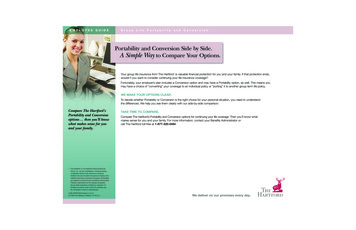
![Pageflex Server [document: A0580431 00001] - Capital Insurance Agency, Inc.](/img/29/dor-hartford-group-term-life-brochure.jpg)
